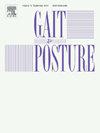一步一步地适应:年轻人和老年人如何克服障碍
IF 2.2
3区 医学
Q3 NEUROSCIENCES
引用次数: 0
摘要
年轻人在接近和跨越障碍物时,会在几个台阶上调整步长,以确保脚在障碍物周围的准确位置,从而避免绊倒。不稳定的步长有两个潜在的影响:它有助于纠正脚的位置,以达到所需的精度,但它也可能通过扰乱支撑基础和整个身体重心的运动或状态之间的关系而损害平衡。因此,在年轻人中,不稳定的步长反映了对绊倒的更大关注,而不是步长的小变化。研究问题:健康的老年人在接近和跨越固定障碍物时是否比年轻人表现出更大的步长不稳定?方法健康的年轻人和老年人多次接近并穿越一个固定的可见障碍物。采用非控制流形方法对跨试验足位数据进行分析,得到了多个接近步骤和跨障碍步骤的步间协方差(ISCz)指数。指数值越大,步长稳定性越好,反之亦然。结果和意义年轻人和老年人在接近和越过障碍物时步长不稳定(ISCz指数降低)(p <; .0001)。老年人的ISCz指数比年轻人低14.5 %,表明他们比年轻人更不稳定步长(p = .02)。考虑到绊倒导致跌倒的成本较高,这种模式可能代表了老年人避免绊倒的理性适应。ISCz指数的这种模式可用于评估临床人群神经肌肉控制系统的健康状况。本文章由计算机程序翻译,如有差异,请以英文原文为准。
Step by adaptive step: How younger and older adults navigate obstacles
Background
Younger adults, while approaching and crossing an obstacle, destabilize step length over several steps to ensure accurate foot placement around the obstacle and thereby avoid a trip. Destabilized step length has two potential effects: it facilitates corrections in foot placements to achieve the required accuracy, but it may also impair balance by perturbing the relation between the base of support and the motion or state of the whole-body center of mass. Therefore, destabilized step length in younger adults reflects a greater concern for tripping versus small variations in step length.
Research question
Do healthy older adults demonstrate greater step length destabilization than younger adults while approaching and crossing stationary obstacles?
Methods
Healthy younger and older adults approached and crossed a stationary visible obstacle multiple times. The across-trial foot placement data were analyzed using the uncontrolled manifold method to obtain the inter-step covariance (ISCz) index for several approach steps and the obstacle crossing step. Higher index value indicates higher step length stability and vice-versa.
Results and significiance
Younger and older adults destabilized step length (ISCz index reduced) while approaching and crossing the obstacle (p < .0001). The ISCz index was 14.5 % lower for older adults indicating that they destabilized step length more than younger adults (p = .02). Given the higher costs of a trip-induced fall, the pattern likely represents a rational adaptation by the older adults to avoid tripping. This pattern in the ISCz index could be used to assess the health of the neuromuscular control system in clinical populations.
求助全文
通过发布文献求助,成功后即可免费获取论文全文。
去求助
来源期刊

Gait & posture
医学-神经科学
CiteScore
4.70
自引率
12.50%
发文量
616
审稿时长
6 months
期刊介绍:
Gait & Posture is a vehicle for the publication of up-to-date basic and clinical research on all aspects of locomotion and balance.
The topics covered include: Techniques for the measurement of gait and posture, and the standardization of results presentation; Studies of normal and pathological gait; Treatment of gait and postural abnormalities; Biomechanical and theoretical approaches to gait and posture; Mathematical models of joint and muscle mechanics; Neurological and musculoskeletal function in gait and posture; The evolution of upright posture and bipedal locomotion; Adaptations of carrying loads, walking on uneven surfaces, climbing stairs etc; spinal biomechanics only if they are directly related to gait and/or posture and are of general interest to our readers; The effect of aging and development on gait and posture; Psychological and cultural aspects of gait; Patient education.
 求助内容:
求助内容: 应助结果提醒方式:
应助结果提醒方式:


